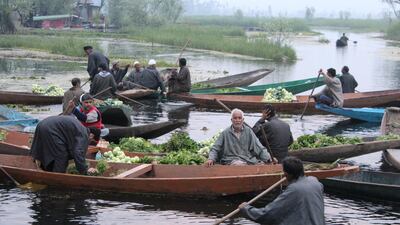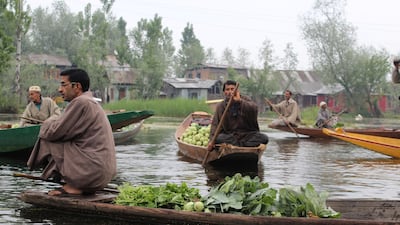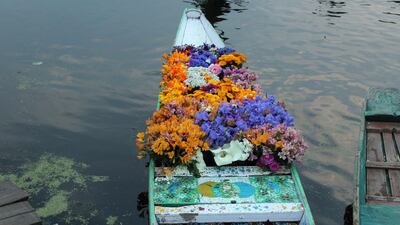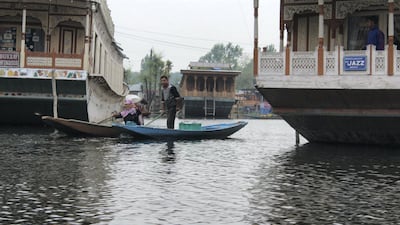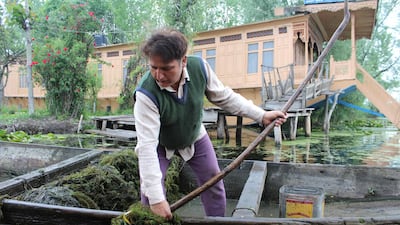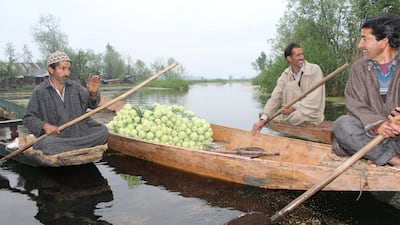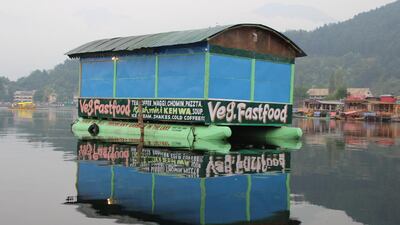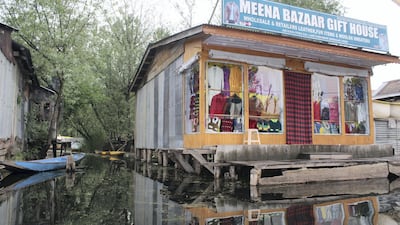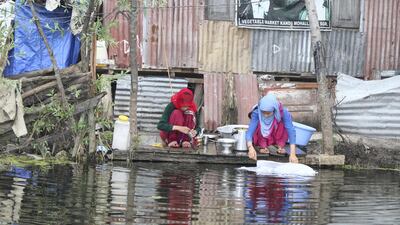On a freezing January morning in Srinagar, Gulam Rasool Akhoon is a bit worried about the inclement weather as he slowly sips his saffron-laced kahwa tea.
The chillai kalan, the coldest 40-day period of the winter in Jammu and Kashmir, has been particularly harsh this year, and he may have to halt his work for a while. With that thought, he pulls himself together, puts on layers of clothing, offers his morning prayers and steps out of his 19th-century home on Dal Lake.
The fierce winds and a temperature of minus 10°C do not deter him; at 62, he feels fit to brave the weather. When the sun begins to show up behind the mountains at 7.30am, Akhoon pulls his deodar wood shikara boat on to the freezing waters of Dal, Srinagar's biggest tourist attraction. Loaded with the previous day's produce of radishes, carrots, turnips, four types of saag and the Kashmiri delicacy nadru (lotus stem), Akhoon rows away to the floating vegetable market minutes from his Nandpura village residence.
Dal Lake's 225-year-old floating vegetable market comes alive with a burst of colour every morning, when shikaras loaded with fruit and vegetables come together to do business. Lake-dwelling farmers – called demb Hanjis – such as Akhoon cultivate produce on their privately owned floating vegetable gardens, known as raadhs, and sell it every morning to vendors who take it to markets across Srinagar and the rest of Kashmir.
In the summer, transactions within the market begin at 4.30am and within an hour or so, money has exchanged hands and the demb Hanjis row their empty shikaras home, seated precariously on one end. It is thought that Dal Lake farmers supply 40 per cent of fruits and vegetables to local and regional markets.
Their lives, however, are as turbulent as the lake is tranquil. Since the 1980s, when an environmental movement started to conserve the shrinking Dal Lake, its dwellers have been held responsible for its degradation and pollution.
According to the 2011 census, the lake and its periphery are home to about 135,000 Hanjis, a minority community. "The Hanji population has grown rapidly and there must be about 80,000 within the lake now," says MRD Kundangar, a hydrobiologist from Srinagar, and founder and former director of the research and development department of Jammu and Kashmir's Lakes and Waterways Development Authority. The organisation was created as an autonomous body by the state government in 1997 to manage and conserve the city's water bodies.
Hanjis live in 58 hamlets on the lake and are involved, apart from farming, in fishing and houseboat tourism. Some sources call them the original inhabitants of Kashmir, while others say they came from Sri Lanka. Akhoon, who is the general secretary of the Dal Dwellers Welfare Union, says that his extended family of now 132 members has been living on the lake for the past 316 years, and that his ancestral home, constructed 149 years ago, still survives.
Agriculture being their primary profession, the family cultivates 19 types of vegetable and fruit on two acres of land. During the summer, Akhoon takes tourists trekking and kayaking and, until a few years ago, he also ran a handicrafts shop on the lake.
"The Hanji farmers are critical to Srinagar's economy," says Ajaz Rasool, an erstwhile hydraulic engineer and environmental activist in Srinagar. Not only do they cater to a large portion of the Valley's vegetable and fruit needs, but their produce is also available during Srinagar's innumerable curfews and closures, since the lake's waterways are always open and the farmers never stop servicing the market. The only exception, Akhoon says, was for a period of 21 months after the 2014 floods, which drowned Srinagar for three weeks.
“The prices of vegetables dropped drastically during the lockdown last year, but we were out in the market every day,” Akhoon says. This has also made farming sustainable for members of this community, who draw their livelihoods from the lake in several ways.
Surveys have found that some Hanjis have illegal dwellings on the lake, but most own portions of land on the lake formalised through the Land Settlement Act of the 1880s. For years, the land owned on the lake could be sold and purchased, until a moratorium was issued on such transactions. Since 1986, the state has made construction within the lake illegal. Even after the 2014 floods, the lake-dwellers were not permitted to carry out any reconstruction of their damaged property.
The shrinking of the lake's water expanse from 25 square kilometres to 12 square kilometres has been attributed to the Hanjis' encroachment and activities. They have been blamed for converting their raadhs into small islands. "They often do this by planting willow trees on the raadh's periphery and topping it up with lake sediment, thus extending the land mass of the lake," Rasool says.
The raadh is fed with aquatic weeds from the lake, which become the minerals and nutrients for the crops. Kundangar explains that the constant extraction of these weeds not only helps to maintain the lake's aesthetics, but has also reduced cases of fish getting entangled in them. Boating also becomes easier when the density of weeds plummets. But this contribution of the Hanjis to the lake is marred by the fact that some of them have begun using synthetic fertilisers, which leach into the water.
Over the years, along with the houseboat Hanjis, who have been condemned for polluting the lake with sewage, the demb Hanjis have been seen as one of the biggest disruptors to the lake's ecology and are in the eye of the storm. However, a study published in the International Journal of Scientific and Engineering Research in 2017 reveals that Srinagar's 15 major drains that "empty into the lake bring along 18.2 tonnes of phosphorous and 25 tonnes of inorganic nitrogen nutrients", and are, in fact, the biggest polluters.
“The Hanjis residing in the hamlets and the 750 houseboat Hanjis stand second and third in their contribution to the lake’s pollution,” Rasool says.
Hundreds of such families have been relocated from the lake over the years, but they are not satisfied with the government’s compensation package and do not find the vocational schemes viable. One conspicuous initiative is the Rakh-e-Arth rehabilitation colony, built in Srinagar in 2007, which has been riddled with problems owing to poor planning.
Anthropologists Mona Bhan and Nishita Trisal in their 2016 essay in the journal Critique of Anthropology note that it is the Hanjis' caste, race and occupational inferiority that has framed a large part of the public discourse around their eviction. They are seen as distinct from other Kashmiris. Bhan and Trisal write how several environmentalists have called the Hanjis "less respectable, quarrelsome and even immoral", frame them "as the bearers of filth and disorder", and have blamed their "vile and scheming" character as the thing that has "ruined and contaminated the lake's pristine waters".
Experts agree that Hanjis are the backbone of the tourism industry in Srinagar, which is key to Jammu and Kashmir's economy, accounting for 7 per cent of the state's GDP.
However, "the lake's carrying capacity is limited", says Kundangar. Even though the Hanjis have a right to live on it, their rapidly increasing population has made their survival unsustainable. But with no alternative livelihoods within government schemes, the Hanjis – particularly those of an older generation with little education and skills limited to activities on the lake – find it difficult to fit into other jobs.
As with many other indigenous communities around the world, the Hanjis may have no choice but to adapt and fend for themselves in the months and years to come.
PROFILE
Name: Enhance Fitness
Year started: 2018
Based: UAE
Employees: 200
Amount raised: $3m
Investors: Global Ventures and angel investors
Muslim Council of Elders condemns terrorism on religious sites
The Muslim Council of Elders has strongly condemned the criminal attacks on religious sites in Britain.
It firmly rejected “acts of terrorism, which constitute a flagrant violation of the sanctity of houses of worship”.
“Attacking places of worship is a form of terrorism and extremism that threatens peace and stability within societies,” it said.
The council also warned against the rise of hate speech, racism, extremism and Islamophobia. It urged the international community to join efforts to promote tolerance and peaceful coexistence.
SQUADS
South Africa:
JP Duminy (capt), Hashim Amla, Farhaan Behardien, Quinton de Kock (wkt), AB de Villiers, Robbie Frylinck, Beuran Hendricks, David Miller, Mangaliso Mosehle (wkt), Dane Paterson, Aaron Phangiso, Andile Phehlukwayo, Dwaine Pretorius, Tabraiz Shamsi
Bangladesh
Shakib Al Hasan (capt), Imrul Kayes, Liton Das (wkt), Mahmudullah, Mehidy Hasan, Mohammad Saifuddin, Mominul Haque, Mushfiqur Rahim (wkt), Nasir Hossain, Rubel Hossain, Sabbir Rahman, Shafiul Islam, Soumya Sarkar, Taskin Ahmed
Fixtures
Oct 26: Bloemfontein
Oct 29: Potchefstroom
The specs
Engine: 2.0-litre 4cyl turbo
Power: 261hp at 5,500rpm
Torque: 405Nm at 1,750-3,500rpm
Transmission: 9-speed auto
Fuel consumption: 6.9L/100km
On sale: Now
Price: From Dh117,059
Abu Dhabi Sustainability Week
The bio
Favourite book: The Alchemist by Paulo Coelho
Favourite travel destination: Maldives and south of France
Favourite pastime: Family and friends, meditation, discovering new cuisines
Favourite Movie: Joker (2019). I didn’t like it while I was watching it but then afterwards I loved it. I loved the psychology behind it.
Favourite Author: My father for sure
Favourite Artist: Damien Hurst
Voy!%20Voy!%20Voy!
%3Cp%3E%3Cstrong%3EDirector%3A%3C%2Fstrong%3E%20Omar%20Hilal%3Cbr%3E%3Cstrong%3EStars%3A%3C%2Fstrong%3E%20Muhammad%20Farrag%2C%20Bayoumi%20Fouad%2C%20Nelly%20Karim%3Cbr%3E%3Cstrong%3ERating%3A%3C%2Fstrong%3E%204%2F5%3C%2Fp%3E%0A
Company Profile
Name: Thndr
Started: 2019
Co-founders: Ahmad Hammouda and Seif Amr
Sector: FinTech
Headquarters: Egypt
UAE base: Hub71, Abu Dhabi
Current number of staff: More than 150
Funds raised: $22 million
Martin Sabbagh profile
Job: CEO JCDecaux Middle East
In the role: Since January 2015
Lives: In the UAE
Background: M&A, investment banking
Studied: Corporate finance
How much of your income do you need to save?
The more you save, the sooner you can retire. Tuan Phan, a board member of SimplyFI.com, says if you save just 5 per cent of your salary, you can expect to work for another 66 years before you are able to retire without too large a drop in income.
In other words, you will not save enough to retire comfortably. If you save 15 per cent, you can forward to another 43 working years. Up that to 40 per cent of your income, and your remaining working life drops to just 22 years. (see table)
Obviously, this is only a rough guide. How much you save will depend on variables, not least your salary and how much you already have in your pension pot. But it shows what you need to do to achieve financial independence.
Dubai World Cup draw
1. Gunnevera
2. Capezzano
3. North America
4. Audible
5. Seeking The Soul
6. Pavel
7. Gronkowski
8. Axelrod
9. New Trails
10. Yoshida
11. K T Brave
12. Thunder Snow
13. Dolkong
Afro%20salons
%3Cp%3E%3Cstrong%3EFor%20women%3A%3C%2Fstrong%3E%3Cbr%3ESisu%20Hair%20Salon%2C%20Jumeirah%201%2C%20Dubai%3Cbr%3EBoho%20Salon%2C%20Al%20Barsha%20South%2C%20Dubai%3Cbr%3EMoonlight%2C%20Al%20Falah%20Street%2C%20Abu%20Dhabi%3Cbr%3E%3Cstrong%3EFor%20men%3A%3C%2Fstrong%3E%3Cbr%3EMK%20Barbershop%2C%20Dar%20Al%20Wasl%20Mall%2C%20Dubai%3Cbr%3ERegency%20Saloon%2C%20Al%20Zahiyah%2C%20Abu%20Dhabi%3Cbr%3EUptown%20Barbershop%2C%20Al%20Nasseriya%2C%20Sharjah%3C%2Fp%3E%0A
The years Ramadan fell in May
The specs: 2018 Renault Koleos
Price, base: From Dh77,900
Engine: 2.5L, in-line four-cylinder
Transmission: Continuously variable transmission
Power: 170hp @ 6,000rpm
Torque: 233Nm @ 4,000rpm
Fuel economy, combined: 8.3L / 100km
More from Neighbourhood Watch:
The Africa Institute 101
Housed on the same site as the original Africa Hall, which first hosted an Arab-African Symposium in 1976, the newly renovated building will be home to a think tank and postgraduate studies hub (it will offer master’s and PhD programmes). The centre will focus on both the historical and contemporary links between Africa and the Gulf, and will serve as a meeting place for conferences, symposia, lectures, film screenings, plays, musical performances and more. In fact, today it is hosting a symposium – 5-plus-1: Rethinking Abstraction that will look at the six decades of Frank Bowling’s career, as well as those of his contemporaries that invested social, cultural and personal meaning into abstraction.
Secret Nation: The Hidden Armenians of Turkey
Avedis Hadjian, (IB Tauris)
The bio
Favourite food: Japanese
Favourite car: Lamborghini
Favourite hobby: Football
Favourite quote: If your dreams don’t scare you, they are not big enough
Favourite country: UAE
88 Video's most popular rentals
Avengers 3: Infinity War: an American superhero film released in 2018 and based on the Marvel Comics story.
Sholay: a 1975 Indian action-adventure film. It follows the adventures of two criminals hired by police to catch a vagabond. The film was panned on release but is now considered a classic.
Lucifer: is a 2019 Malayalam-language action film. It dives into the gritty world of Kerala’s politics and has become one of the highest-grossing Malayalam films of all time.
David Haye record
Total fights: 32
Wins: 28
Wins by KO: 26
Losses: 4
Results
5pm: Al Falah – Maiden (PA) Dh80,000 (Turf) 1,200m; Winner: Bshara, Richard Mullen (jockey), Salem Al Ketbi (trainer)
5.30pm: Wathba Stallions Cup – Handicap (PA) Dh70,000 (T) 1,400m; Winner: AF Musannef, Tadhg O’Shea, Ernst Oertel
6pm: Al Dhafra – Maiden (PA) Dh80,000 (T) 1,600m; Winner: AF Mualami, Antonio Fresu, Abubakar Daud
6.30pm: Al Khaleej Al Arabi – Handicap (PA) Dh80,000 (T) 1,600m; Winner: Hawafez, Adrie de Vries, Abubakar Daud
7pm: Al Mafraq – Handicap (PA) Dh80,000 (T) 1,600m; Winner: JAP Almahfuz, Royston Ffrench, Irfan Ellahi
7.30pm: Al Samha – Handicap (TB) Dh80,000 (T) 1,600m; Winner: Celestial Spheres, Patrick Cosgrave, Ismail Mohammed
Important questions to consider
1. Where on the plane does my pet travel?
There are different types of travel available for pets:
- Manifest cargo
- Excess luggage in the hold
- Excess luggage in the cabin
Each option is safe. The feasibility of each option is based on the size and breed of your pet, the airline they are traveling on and country they are travelling to.
2. What is the difference between my pet traveling as manifest cargo or as excess luggage?
If traveling as manifest cargo, your pet is traveling in the front hold of the plane and can travel with or without you being on the same plane. The cost of your pets travel is based on volumetric weight, in other words, the size of their travel crate.
If traveling as excess luggage, your pet will be in the rear hold of the plane and must be traveling under the ticket of a human passenger. The cost of your pets travel is based on the actual (combined) weight of your pet in their crate.
3. What happens when my pet arrives in the country they are traveling to?
As soon as the flight arrives, your pet will be taken from the plane straight to the airport terminal.
If your pet is traveling as excess luggage, they will taken to the oversized luggage area in the arrival hall. Once you clear passport control, you will be able to collect them at the same time as your normal luggage. As you exit the airport via the ‘something to declare’ customs channel you will be asked to present your pets travel paperwork to the customs official and / or the vet on duty.
If your pet is traveling as manifest cargo, they will be taken to the Animal Reception Centre. There, their documentation will be reviewed by the staff of the ARC to ensure all is in order. At the same time, relevant customs formalities will be completed by staff based at the arriving airport.
4. How long does the travel paperwork and other travel preparations take?
This depends entirely on the location that your pet is traveling to. Your pet relocation compnay will provide you with an accurate timeline of how long the relevant preparations will take and at what point in the process the various steps must be taken.
In some cases they can get your pet ‘travel ready’ in a few days. In others it can be up to six months or more.
5. What vaccinations does my pet need to travel?
Regardless of where your pet is traveling, they will need certain vaccinations. The exact vaccinations they need are entirely dependent on the location they are traveling to. The one vaccination that is mandatory for every country your pet may travel to is a rabies vaccination.
Other vaccinations may also be necessary. These will be advised to you as relevant. In every situation, it is essential to keep your vaccinations current and to not miss a due date, even by one day. To do so could severely hinder your pets travel plans.
Source: Pawsome Pets UAE
The specs: 2018 Mazda CX-5
Price, base / as tested: Dh89,000 / Dh130,000
Engine: 2.5-litre four-cylinder
Power: 188hp @ 6,000rpm
Torque: 251Nm @ 4,000rpm
Transmission: Six-speed automatic
Fuel consumption, combined: 7.1L / 100km
UAE currency: the story behind the money in your pockets
UAE%20set%20for%20Scotland%20series
%3Cp%3EThe%20UAE%20will%20host%20Scotland%20for%20a%20three-match%20T20I%20series%20at%20the%20Dubai%20International%20Stadium%20next%20month.%3Cbr%3EThe%20two%20sides%20will%20start%20their%20Cricket%20World%20Cup%20League%202%20campaigns%20with%20a%20tri-series%20also%20involving%20Canada%2C%20starting%20on%20January%2029.%3Cbr%3EThat%20series%20will%20be%20followed%20by%20a%20bilateral%20T20%20series%20on%20March%2011%2C%2013%20and%2014.%3C%2Fp%3E%0A
ILT20%20UAE%20stars
%3Cp%3E%3Cstrong%3ELEADING%20RUN%20SCORERS%3C%2Fstrong%3E%3Cbr%3E1%20Nicholas%20Pooran%2C%20261%3Cbr%3E%3Cstrong%3E2%20Muhammad%20Waseem%20(UAE)%2C%20248%3C%2Fstrong%3E%3Cbr%3E3%20Chris%20Lynn%2C%20244%3Cbr%3E4%20Johnson%20Charles%2C%20232%3Cbr%3E5%20Kusal%20Perera%2C%20230%3Cbr%3E%3Cbr%3E%3Cstrong%3EBEST%20BOWLING%20AVERAGE%3C%2Fstrong%3E%3Cbr%3E(minimum%2010%20overs%20bowled)%3Cbr%3E%3Cstrong%3E1%20Zuhaib%20Zubair%20(UAE)%2C%209%20wickets%20at%2012.44%3Cbr%3E2%20Mohammed%20Rohid%20(UAE)%2C%207%20at%2013.00%3C%2Fstrong%3E%3Cbr%3E3%20Fazalhaq%20Farooqi%2C%2017%20at%2013.05%3Cbr%3E4%20Waqar%20Salamkheil%2C%2010%20at%2014.08%3Cbr%3E%3Cstrong%3E5%20Aayan%20Khan%20(UAE)%2C%204%20at%2015.50%3C%2Fstrong%3E%3Cbr%3E6%20Wanindu%20Hasaranga%2C%2012%20at%2016.25%3Cbr%3E%3Cstrong%3E7%20Mohammed%20Jawadullah%20(UAE)%2C%2010%20at%2017.00%3C%2Fstrong%3E%3C%2Fp%3E%0A
Benefits of first-time home buyers' scheme
- Priority access to new homes from participating developers
- Discounts on sales price of off-plan units
- Flexible payment plans from developers
- Mortgages with better interest rates, faster approval times and reduced fees
- DLD registration fee can be paid through banks or credit cards at zero interest rates


